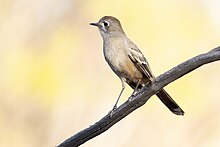| Southern scrub robin | |
|---|---|

| |
| Conservation status | |
 Least Concern (IUCN 3.1) | |
| Scientific classification | |
| Domain: | Eukaryota |
| Kingdom: | Animalia |
| Phylum: | Chordata |
| Class: | Aves |
| Order: | Passeriformes |
| Family: | Petroicidae |
| Genus: | Drymodes |
| Species: | D. brunneopygia |
| Binomial name | |
| Drymodes brunneopygia Gould, 1841 | |
The southern scrub robin (Drymodes brunneopygia) is a species of bird in the family Petroicidae. It is endemic to Australia, where it occurs in mallee and heathland in the semi-arid southern parts of the continent, extending from Wyperfeld National Park in Victoria in the east through South Australia to the west coast between Kalbarri and the Pinnacles in Nambung National Park.
Taxonomy
The southern scrub robin was formally described in 1841 by the English ornithologist John Gould under the current binomial name Drymodes brunneopygia. Gould noted that the bird was found near the Murray River in South Australia. The specific epithet combines the Modern Latin brunneus meaning "brown" with the Ancient Greek -pugios meaning "-rumped". The species is monotypic: no subspecies are recognised.
Description
It is a relatively dull and large robin, adults being around 22 centimetres (9 in) in length, of which around a third is the tail feathers. Most of the plumage is grey, except for a dullish red tail and patterned black-and-white wings. The legs are unusually long for a passerine, and are frequently used to hop through the dense heathland that forms the bird's habitat, where it searches for insects and other small invertebrates.
Behaviour
Breeding
The birds breed between July and December. The nest is built of twigs on the ground and is lined with twigs, grass and bark. Unusually for a passerine, the southern scrub robin lays only a single egg. It is grey-green in colour for camouflage amongst the sclerophyllous flora that forms its habitat. The egg is incubated for sixteen days. The young leave the nest after 10-13 days but continue to be fed by both parents.
Status
The species is listed under the IUCN Red List of Threatened Species as a species of 'Least concern'. In New South Wales it is listed as Vulnerable under the Biodiversity Conservation Act 2016.
References
- ^ BirdLife International (2016). "Drymodes brunneopygia". IUCN Red List of Threatened Species. 2016: e.T22704928A93991228. doi:10.2305/IUCN.UK.2016-3.RLTS.T22704928A93991228.en. Retrieved 13 November 2021.
- Gould, John (1840). "Drymodes brunneopygia". Proceedings of the Zoological Society of London. 8 (95): 170–171. Although the volume has the year 1840 on the title page, the article did not appear until 1841. For the publication date see: Sclater, P.L. (1893). "List of the dates of delivery of the sheets of the 'Proceedings' of the Zoological Society of London, from the commencement in 1830 to 1859 inclusive". Proceedings of the Zoological Society of London: 436–440 .
- Mayr, Ernst; Paynter, Raymond A. Jr, eds. (1964). Check-list of Birds of the World. Vol. 10. Cambridge, Massachusetts: Museum of Comparative Zoology. p. 29.
- Dickinson, E.C.; Christidis, L., eds. (2014). The Howard & Moore Complete Checklist of the Birds of the World. Vol. 2: Passerines (4th ed.). Eastbourne, UK: Aves Press. p. 258. ISBN 978-0-9568611-2-2.
- Jobling, James A. (2010). The Helm Dictionary of Scientific Bird Names. London: Christopher Helm. p. 79. ISBN 978-1-4081-2501-4.
- Gill, Frank; Donsker, David; Rasmussen, Pamela, eds. (July 2023). "Australasian robins, rockfowl, rockjumpers, Rail-babbler". IOC World Bird List Version 13.2. International Ornithologists' Union. Retrieved 26 December 2023.
- Boles, W.E. (2007). "Family Petroicidae (Australasian robins)". In del Hoyo, J.; Elliott, A.; Sargatal, J. (eds.). Handbook of the Birds of the World. Vol. 12: Picathartes to Tits and Chickadees. Barcelona, Spain: Lynx Edicions. pp. 438–489 . ISBN 978-84-96553-42-2.
- "Southern Scrub-robin - profile". NSW Office of Environment & Heritage. Retrieved 16 December 2023.